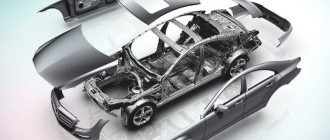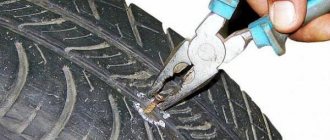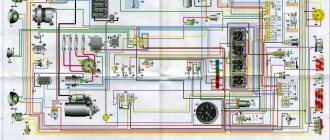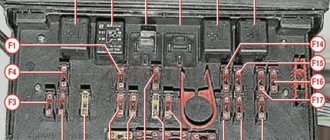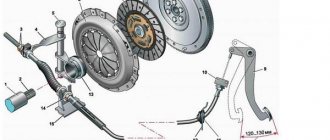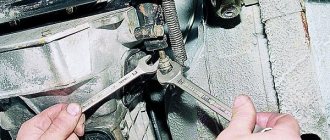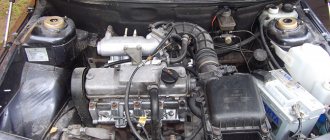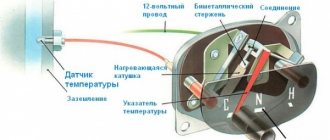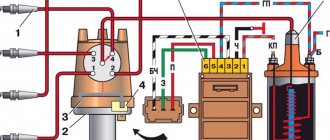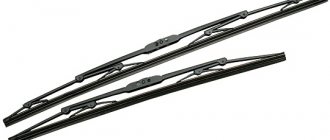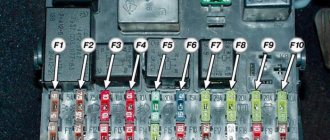Body frame parts
1 – radiator frame lining;
2 – radiator frame; 3 – upper cross member of the radiator frame; 4 – right front wing; 5 – front panel; 6 – hood hinge; 7 – hood; 8 – right front door; 9 – wind window pillar; 10 – interior panel of the front door; 11 – inner panel of the rear door; 12 – right rear door; 13 – frame of the roof hatch; 14 – left side; 15 – roof panel; 16 – rear suspension spring support; 17 – trunk lid; 18 – inner panel of the trunk lid; 19 – side window frame; 20 – rear bumper; 21 – rear pillar; 22 – left rear door; 23 – rear wheel arch; 24 – middle floor; 25 – spare wheel niche; 26 – central pillar; 27 – left front door; 28 – front pillar; 29 – front floor; 30 – left front fender; 31 – front suspension spring support; 32 – bracket; 33 – front spar; 34 – towing eye bracket; 35 – front panel; 36 – front bumper The body of the VAZ-2110 car is a monocoque four-door sedan, consisting of a body frame and attachments.
The body frame includes a base, sidewalls, roof and frame parts, connected to each other by electric welding (spot, seam and arc), and is a non-separable structure that has sufficient rigidity and is capable of carrying all the components of the car, mounted body components, components and interior details, etc.
Attachment components include the side doors, hood, trunk lid, front fenders, bumpers and radiator trim.
The doors, hood and trunk lid are attached to the body using hinges. The front fenders are attached to the body with bolts.
The front and rear buffers are secured with bolts. The radiator trim is secured using plastic clips and two bolts.
The windshield is three-layer “Triplex” type. Door glass, side and rear glass are tempered. The windshield, rear and side windows are glued to the body.
The front seats are separate, with backrest tilt adjustment and longitudinal movement mechanisms, with easily removable headrests, adjustable in height. The back of the front seats can be adjusted to a comfortable position for relaxation.
The rear seat has a one-piece cushion and a backrest divided into two parts by a folding armrest. Behind the armrest there is a hatch that can be closed with a lid, after removing which it becomes possible to transport long items in the trunk, partially letting them into the cabin.
The front and rear side seat belts are inertial, and the rear middle passenger lap belt is non-inertial.
The car interior is equipped with a cigarette lighter, front and rear ashtrays, sun visors, a heater, rear-view mirrors, and handrails. There is a mount for a fire extinguisher under the driver's seat, and a first aid kit under the passenger's seat.
The vehicle is equipped with front and rear towing eyes. In a variant version, the body can be equipped with headlight cleaners and washers, front wheel aprons, an additional brake signal, sill fairings, an air conditioning system, electric door locks, an electric trunk lock, electrically heated front seats, and side door safety linings.
The ventilation and heating of the interior is controlled automatically by the controller. If the car is equipped with an air conditioning system, the controller also controls the microclimate in the cabin automatically. Some of the cars produced can be equipped with a manually controlled ventilation and heating system.
The body has exhaust ventilation through deflectors with valves installed at the ends of the front and rear doors.
.. 170 171 172 173 174 175 176 177 178 179 180 ..
Lada VAZ-2110 (2111, 2112). Body
Body frame parts: 1 — radiator grille; 2 — radiator frame; 3 — upper cross member of the radiator frame; 4 — right front wing; 5 — front panel; 6 — hood hinge; 7 — hood; 8 — right front door; 9 — wind window pillar; 10 — interior panel of the front door; 11 — inner panel of the rear door; 12 — right rear door; 13 — roof reinforcement; 14 — left side; 15 — roof panel; 16 — rear suspension spring support; 17 — trunk lid; 18 — inner panel of the trunk lid; 19 — side window frame; 20 — rear bumper; 21 — rear pillar; 22 — left rear door; 23 — rear wheel arch; 24 - middle floor; 25 — spare wheel niche; 26 — central pillar; 27 — left front door; 28 — front pillar; 29 — front floor; 30 — left front fender; 31 — front suspension spring support; 32 — bracket; 33 — front spar; 34 — bracket for towing eye; 35 — front panel; 36 — front bumper.
Description of design The body is all-metal, welded, load-bearing structure. Most of the body panels are galvanized to improve their anti-corrosion properties. Electrozinc is applied on the inside to the front and middle floor panels, the side of the body, the wind strut amplifier, the outer panels of the trunk lid and doors, the front and rear fenders and a number of other parts (more than 30 positions in total). The rear wheel arches are galvanized on the outside. The rear panel, cross members and floor connectors, the inner panel of the trunk lid and hood, the trunk lid reinforcement and a number of other parts are coated with electrozinc on both sides. The engine splash guard, radiator frame, AB platform, gas tank flap cover, extensions and connectors of the rear wheel arches and a number of other parts (about 10 positions) are treated with hot-dip galvanizing (on both sides). The thickness of the main body panels is 0.8 mm. The body elements are connected to each other by contact welding, and in hard-to-reach places by semi-automatic electric welding in an inert gas environment. Panel joints and welds are sealed with mastic. After welding the panels, the body is phosphated, electrophoretic and secondary primers are applied and painted. Hidden body cavities are treated at the factory with the Oremin preservative. All glass is curved, polished, safety type. The windshield is three-layer, the door glass and rear window are tempered. Rear window - with heating element. The windshield, rear and side windows are glued into the body openings and are part of its power circuit. Door glass is sliding.
Energy-absorbing bumpers are installed at the front and rear. Removable body parts: doors 8, 12, 22, 27, trunk lid 17, hood 7, front fenders 4 and 30, bumpers 20 and 36. The front seats are separate, with adjustment of longitudinal movement and backrest tilt. Headrests are removable and height adjustable. The rear seat has a one-piece folding cushion. The backrest is divided into two parts by a folding armrest. Behind the armrest there is a hatch with a lid. By folding the armrest and lid, you can transport long items in the trunk, partially placing them in the cabin. The front and rear side seats are equipped with seat belts with inertia reels, the middle one is equipped with only a lap belt. In a variant version, the car can be equipped with headlight cleaners and washers, an additional brake signal, door sill fairings, an air conditioning system, electric door locks, electric windows, an electric trunk lock, electric heated front seats, a “Lux” instrument panel, an on-board computer, mirrors with electric drive and electric heating. The interior heating and ventilation system is described in the “Heating and Ventilation” section.
Bodies and what they are like
ATTENTION! A completely simple way to reduce fuel consumption has been found! Don't believe me? An auto mechanic with 15 years of experience also didn’t believe it until he tried it. And now he saves 35,000 rubles a year on gasoline! Read more"
As you know, the body on the “ten” is load-bearing and repeats the basic design of any modern passenger car. Today it is customary to talk about several types of bodywork. The frame and supporting body are considered the main ones.
The difference between frame and load-bearing
How much does the body of a VAZ 2110 weigh?
All the main components of the car are located on the frame; it serves as a support and is itself fixed to the wheels of the car by means of suspensions. If you pay attention to trucks, then the frame can be seen with the naked eye, and thus you can draw appropriate conclusions about its structure. In “passenger cars” there is no frame, or it would be more accurate to say that on some passenger cars the frame-body assortment forms a single whole, called the body.
Frameless bodies, which include the metal frame of the VAZ 2110, are made in such a way as to withstand the mass of numerous heavy components. For this purpose, the body floor is well reinforced, and most of the overall parts are made of materials with a lightweight base.
On frameless bodies, the role of the frame is performed by the spars. They can be said to be responsible for the massiveness of the entire body structure. From time to time, these components are subjected to unplanned and shock loads that change very quickly in different directions. This operating scenario cannot have a positive effect, and over time, the welding points break, the bolts become loose, and the solidity of the entire body structure weakens.
VAZ 2110 body diagram
The car body also feels the load from a running engine. It vibrates strongly, although the engine itself and the cylinders are designed to absorb some of the vibrations. To minimize the effects of vibrations on the body, manufacturers use special cushions or dampers, as well as washers made of dense rubber.
Note. The effect of these pads can be clearly determined by monitoring the operating unit with the hood open. The engine “growls” and shakes, but the body doesn’t care.
The most important task of a frameless car body is to transport luggage and passengers. At the same time, the machine must also provide major protection. The number of people transported and the weight of the permissible load are determined by the designers responsible for the layout and other parameters of the body.
If you imagine the frame of a “car” in the form of its components, then its main parts are three main zones, implying the trunk, the passenger compartment and the front. The finished look of the solidity of the frame is given by its hinged parts or “plumage”, which includes various panels.
Body types of the “tenth” family
VAZ 2110 body diagram
The difference in body types, again, is associated with what one or another model is intended for. The car may be intended for off-road travel, and then it will be designed as a crossover or a full-fledged all-terrain vehicle, or it may be intended only for city driving.
Note. The body of the VAZ 2110 is a typical sedan. Models associated with the “ten” already have other body types: 2111 – station wagon, 2112 – 5-door hatchback, 21123 – coupe or 3-door hatchback.
It will be useful to know that over the entire production period of the 2110 model, VAZ creates many variations of this sedan. In particular, the Consul limousine, with an even longer wheelbase, deserves attention.
The design of the sedan began immediately after the VAZ 2108 became obsolete, when the plant decided to replace the project. But the release of the “ten” was not yet imminent. The fact is that the designers made many revolutionary improvements that significantly increased the cost of the project. Due to the economic crisis that reigned in the country at that time, the project was moved forward several years, and only in 1995 mass production of the “ten” began.
VAZ 2110 body diagram of station wagon 2111
The sedan is the classic and most popular body style of modern cars. The interior includes 2 rows of seats and usually accommodates 4-5 people including the driver. The luggage compartment in sedans is properly separated from the interior.
For many, to this day, the question of the merits of the VAZ 2110 car is somewhat controversial. It is clear that it cannot compare with foreign cars, but the presence of “ten” running on the roads of our country speaks volumes.
Dimensions and how much it weighs
The body length of the “ten” sedan is 4265 mm, which is only slightly less than the “universal” dimensions. This length looks the most organic not only among the models of the “tenth” family, but also in VAZ as a whole.
Instructions for VAZ 2110 body dimensions and repairs
We also note that the length of the “ten” is 6 cm longer than the length of the only “Samarov” sedan - VAZ 21099. The same goes for other parameters:
- The longitudinal distance between the wheel axles is 3.2 s longer;
- Body height is 1.8 cm higher;
- Ground clearance is 5 cm higher.
But both gauges are the same for “99” and “tens”. In addition, both models have similar gearboxes and engines. But still, in general, the technical characteristics of the “tens” and “99” are different. The “Ten” is able to achieve better speed and demonstrate enviable maneuverability on the road compared to the “99”, precisely due to the body design, made with modernizations and significant improvements. In particular, these are smooth body lines and completely modernized control systems.
Due to the greater length, which experts called “ideally sufficient,” the trunk of the VAZ 2110 sedan becomes very spacious. Its usual layout is 415 liters, which is already the envy of competitors.
Dimensions 2110
The large volume of the luggage compartment allows you to transport by car not only the essentials, including a spare wheel and tools, but also many additional things. If you remove the rear seats, turning the rear of the cabin into an additional trunk, you can transport up to 1270 liters of cargo.
The wheelbase of the “ten” is 2492 mm, which is also very good. If we add to this the length of the trunk - 944 mm, then on a long journey, if you have a sleeping mattress, you can make a quite comfortable bed.
VAZ's new sedan is wider, taller and longer, but also heavier than the standard family of cars (1020 kg). This was to be expected, because the designers sought to increase the interior space, thereby increasing the comfort of people sitting in the cabin.
Specifications
During the production of the 2110 model, the Volzhsky plant created more than a dozen different modifications of this sedan, including the Consul limousine with a greatly increased wheelbase. However, most of the cars were produced in the following modifications:
- 2110-010.
- 21102.
- 21103.
Technical characteristics of model 2110-010:
- curb weight - 1010 kg;
- maximum weight of passengers and luggage - 470 kg;
- engine brand - 2110;
- power type - carburetor;
- volume - 1.5 liters;
- power - 72 hp;
- acceleration to 100 - 14 s;
- highest speed - 165 km/h;
- average gasoline consumption in the combined cycle is 6.6 liters.
Technical characteristics of model 21102:
- curb weight - 1020 kg;
- maximum weight of passengers and luggage - 460 kg;
- engine brand - 2111;
- volume - 1.5 liters;
- power - 76 hp;
- acceleration to 100 - 14 s;
- highest speed - 170 km/h;
- average gasoline consumption in the combined cycle is 7.1 liters.
https://www.youtube.com/watch?v=fexLt8S-d80{amp}amp;index=4{amp}amp;list=PLpYsjEHSSgxAs_m10_DAZ5J7oBloYvO4s
Technical characteristics of model 21103:
- curb weight - 1060 kg;
- maximum weight of passengers and luggage - 455 kg;
- engine brand - 2112;
- power type - distributed injection;
- volume - 1.5 liters;
- power - 93.5 hp;
- acceleration to 100 - 12.5 s;
- highest speed - 185 km/h;
- average gasoline consumption in the combined cycle is 7.2 liters.
Tens body care and repairs
Do-it-yourself VAZ 2110 body repair
The overall body of the “ten” looks more reliable, durable and resistant to corrosion. All-metal and partially galvanized, it comes off the assembly line already treated with anticorrosive, ready for harsh operating conditions.
On the other hand, we must pay tribute to our car owners, who are accustomed to finishing everything with their own hands. In particular, while remaining adherents of the domestic automobile industry, they turn a blind eye to the differences and shortcomings of technology in comparative terms and take additional care of the body so that it serves for many years without problems. Russian car owners almost always add special protection to the standard anti-corrosion treatment.
VAZ 2110 body repair and polishing
Preventative work specifically involves tinting the bottom of the car, treating sills and fender liners with Movil.
Note. We can say with confidence that among the “dozens” with high mileage, even today you can find examples that have been so well cared for by the owner that they look like new.
People's love for the “ten” is also symbolized by the succinct names given to the car by amateurs. “Matryoshka”, “pregnant antelope”, “chubby” - all these nicknames, albeit with some degree of irony, speak of love for the car. If at first the unique, new design of the VAZ model raised questions, then over time the angular shapes of the “bow” and “stern” became familiar.
Here are the preventive works that are usually carried out on the body of the “tens” throughout the entire operational period:
- Caring for paintwork;
- Lubrication of metal components of the body;
- Cleaning of technical holes;
- Periodic anti-corrosion protection of the body as a whole and treatment of hidden areas;
- Noise insulation;
- Sealing.
VAZ 2110 body repair
To protect the original paintwork of the body, you must be able to select the appropriate polishes and follow the rules for their application. In addition, the VAZ 2110 must first be washed when the car is new, only with cold water, and for treating paintwork, use polishes that do not contain abrasives.
Caring for the paintwork of a car with a 3-5 year mileage implies a different scenario:
- Use products for weathered surfaces (they contain a certain amount of abrasive).
Accordingly, for a body older than 5 years:
- Use products specifically designed for aged surfaces.
It is also recommended to polish the body in small areas by hand using clean flannel. This is done to prevent the polish from drying out during application.
Polishes PMA-1 and PMA-2 have proven themselves well.
Body polish
More good tips on the body in general:
- Do not store the car under rubber covers;
- Do not place rubber objects on painted surfaces (they will leave stains that are almost impossible to remove);
- Protect the paintwork from contact with alkalis, brake fluid and other chemicals that can destroy the coating.
It is recommended to lubricate rubbing parts and body elements from time to time in order to increase the durability of the metal frame. So, this should be done at least every 15 thousand km of the car or once a year.
Here's how and where to do it:
- Apply engine oil to door hinges;
- Apply CV joint grease-4 or Molikot to the limiters;
- Lubricate door locks with FIOL-1;
- Apply VTV-1 aerosol lubricant to the lock cylinders;
- Use the same product to lubricate the hinges and springs of the fuel tank hatch;
- Lubricate the hood lock with FIOL-1;
- Use the same tool to lock the trunk lid.
Anticorrosive treatment also needs to be given great attention. Hollow parts of the body and parts located in the lower part are most susceptible to the negative effects of rye (they are constantly exposed to moisture and dirt due to their close location to the road surface).
It has proven itself well for protecting the metal components of the body from corrosion. As for the treatment period, it is recommended to carry it out every year.
Due to the complexity of the work, it is recommended to treat hidden body cavities with anticorrosive agents at a service station. If the garage has the appropriate tools and equipment, then the process is as follows:
- The car is placed on a jack;
- The casing and all components that interfere with access to hidden cavities are removed;
- The holes are washed until clean water flows out;
- The surfaces are thoroughly dried, and all areas where the anticorrosive is applied are blown with compressed air.
The table below shows hidden cavities and how to apply anticorrosive.
Instrumental check by checkpoints
And yet, things are not always so simple. And even an experienced eye will not always notice small “inconsistencies”. With proper body repair, the geometric dimensions can only be checked by taking measurements. Professionals use special meters for this.
But to carry out this procedure at home, an ordinary tape measure is sufficient. You need to find special control marks that are located on the bottom of the VAZ body. It is from them that measurements should be taken. How and in what sequence can be found in the operating instructions for the VAZ 2110.
If, say, you need to make sure that the linear dimensions of your particular car (for example, you changed the wings, door, etc.) match, then you should not always trust even the operating instructions; sometimes you can find errors there too.
As control dimensions of the body, use the dimensions you personally took from the side of the car where no replacements or straightening were carried out.
Hidden body cavities and their processing
| Cavity name | Injection point | Composition injection direction | Additional instructions |
| Hood pockets | In the openings of the interior upholstery | Over the entire inner surface | Open the hood |
| Door pockets | In the panel openings under the upholstery | Along the inner surface of the bottom | Remove the upholstery |
| Cavities between wheel arches and rear fenders | From the trunk | Over the entire inner surface | Open the trunk |
| Rear floor rails | Below the body, in the trunk and under the rear seat | Forward and backward | Open the trunk, lift the seat cushion |
| Middle floor cross member | Below the body and under the rear seat | Right and left | Raise the seat cushion |
| Front floor cross member | From the interior and from below the body | Right and left | Remove the floor mats |
| Door thresholds | From the interior, from the front and rear ends of the threshold | Forward and backward | Remove the floor mats |
| Front side members | From the interior and from below the body | Forward and backward | Hang up the car |
| Bulkhead shield reinforcement cavities | From the interior and engine compartment | Right and left | Open the hood, remove the floor mats |
| Floor Threshold Connector Cavities | Bottom of the body | Over the entire inner surface | Hang up the car |
| Rear lower cross member | Behind the car | Right and left | Remove the rear bumper |
Body care work is usually limited to this. You can get more detailed information on the VAZ 2110 body from other articles on our website or through photo materials and diagrams.
Tired of paying fines? There is an exit!
Forget about fines from cameras! An absolutely legal new product - Traffic Police Camera Jammer, hides your license plates from the cameras that are installed in all cities.
- Absolutely legal (Article 12.2);
- Hides from photo and video recording;
- Suitable for all cars;
- Works through the cigarette lighter connector;
- Does not cause interference to radios and cell phones.
Innovations in production
To begin with, I would like to draw your attention to the fact that the body of the VAZ 2110 car is a completely domestic development, and this is not entirely typical for the Soviet automobile industry. The body of the new VAZ 2110 car has adopted the best technical solutions from its prototype. Unlike the eight, the body has become more complex, although the total number of parts has decreased, and the number of welding points has increased by 10% to 478. The desire to improve aerodynamic properties forced the manufacturer to complicate the shape of many parts. This, in turn, led to an increase in the number of stamped parts. The project for the production of a new body was accompanied by a complete renovation of the entire production line; new stamping presses, welding stations, special washing machines and other units were installed. This update had a positive effect on the quality of parts manufacturing.
The VAZ 2110 body is distinguished by the number of galvanized parts. The volume of galvanized steel used in the production of the body reaches 52% of its weight.
Robotic technology has begun to be actively used in production for welding galvanized parts.
Factory treatment of internal surfaces and areas hazardous to corrosion with special protective preparations, which, in combination with high-quality paints and varnishes, guarantees anti-corrosion resistance for at least 6 years. It is worth remembering our car owners, because they themselves pay special attention to the car body: they tint, clean, and treat with anti-corrosion compounds.

